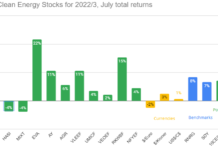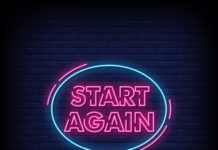Tom Konrad CFA
The third quarter earnings season has been quite eventful for my Ten Clean Energy Stocks for 2013 and six alternative picks model portfolios, so much so that writing about them has taken a back seat to keeping up with the announcements. There were a number of earnings disappointments and earnings announcements which were in line with my expectations but the market treated like disappointments. These resulted in an overall decline of 2.5% for the portfolio since the last update, even as my industry benchmarks, the Powershares Wilderhill Clean Energy (PBW) and my small cap benchmark (IWM) were up 1.0% and 3.9% over the months since October 15th.

Individual Stocks
The only good news came from ground-source heat pump manufacturer Waterfurnace Renewable Energy (TSX:WFI, OTC:WFIFF.) Waterfurnace reported earnings up 51% compared the previous-year period. The strong results arose from a large increase in sales to Canada, as that market recovered from the end of a federal incentive program in March 2012. Also benefiting earnings was a decrease in operating expenses due to successful cost reduction efforts in 2012. Analysts at Canaccord Genuity raised their price target for Waterfurnace from C$25 to C$29 in response to the results. Waterfurnace rose 18% for the month.
Leading environmental services firm Waste Management (NYSE:WM) also rose significantly, up 10% for the month, despite the fact that earnings were in line with analysts’ expectations. While I consider Waste Management a long term hold as a reliable dividend stock, I’ve taken advantage the recent price appreciation to increase my income from the position by selling covered calls.
The market reacted negatively to strong earnings at utility demand-side management contractor Lime Energy (NASD:LIME). The company has been making excellent progress shedding unprofitable business lines and focusing on its utility business, with revenue from continuing operations jumping 55% and gross profit up 125% compared to the comparable quarter a year ago. Unfortunately, liquidity still remains a significant issue at Lime, despite its September raise of $2.5 million and conversion of debt into preferred stock in September. The liquidity section of Lime’s third quarter report states, “While it is possible that our current capital will be sufficient to carry us until we reach profitability, it is also possible that we will need to raise additional capital before our cash flow turns positive and we are able to internally fund our operations.”
Investors are most likely selling in anticipation of another round of funding which could further dilute existing shareholders. The company is fortunate to have a number of large shareholders who see the potential of its utility business and have been willing to repeatedly step up to cover its cash needs. Given the strength of its utility business, I anticipate that they will only need to come back for one more round.
Although turnkey Energy Service Company (ESCO) Ameresco, Inc. (NASD:AMRC) continued to grow its backlog at a 15% rate compared to the previous quarter, conversion rates continue to disappoint. Last quarter Ameresco’s CEO, George Sakellaris stated that he saw conditions improving, but revenue grew only 9% year over year, in large part due to five delayed renewable energy projects and customer delays in both the US and Canada. Historically, it has taken 6 to 12 months for Ameresco to convert projects in the backlog to revenue.
Although this is the fifth consecutive quarter that Ameresco has missed earnings, I don’t think there is anything fundamentally wrong with its business model. Navigant predicts that the energy service business will grow 8% next year and reach $8.3 billion by the end of the decade from $4.9 billion this year. Ameresco is already seeing a pick-up in both its revenue and backlog, while rivals such as Johnson Controls (NYSE:JCI) have yet to see improvement. I took the opportunity of the sell off to add to my position.
Kandi Technologies (NASD:KNDI)
Chinese EV and off road vehicle manufacturer Kandi Technologies has been growing its legacy off road vehicle business rapidly, but sales of EVs have yet to take off, with only 494 sold during the quarter. I expect the pace of EV sales to pick up significantly in the fourth quarter. EV sales should be driven by now that China’s much-delayed subsidy for “New Energy Vehicles” has been renewed. This seems to favor makers of low-speed electric vehicles like Kandi. The roll-out of a public EV sharing system using Kandi vehicles in the city of Hangzhou should also contribute to EV sales this quarter, as could its joint venture to build EVs with Geely Automotive.
On the other hand, I found the announcement on October 28th that Kandi was purchasing $30.3 million worth of batteries for the roll-out of the Hangzhou public EV sharing system concerning. Under the original agreement, the batteries were to have been supplied by Air Lithium (Lyoyang) Co. Ltd.and paid for by the local utility. The capital-light model of getting others to pay for the most expensive EV component, the battery, was one of the things which attracted me to Kandi in the first place. Now Kandi seems to be buying the batteries itself.
With current liabilities already exceeding current assets by $133 million to $89 million, I would not be surprised if Kandi has to raise more capital soon in order to increase the pace of EV sales significantly.
I still hold the short $10 KNDI calls expiring in December I mentioned in the last update.
Alterra Power (TSX:AXY, OTC:MGMXF)
Diversified renewable power operator and developer Alterra had a strong quarter, producing a profit of 3 cents a share for the quarter compared to 2 cents for the prior year. More importantly, EBITDA is rising as a result of Alterra’s investment program. At C$0.30 a share, the company has an Enterprise Value of only 9-10 times 2013 EBITDA. More mature Canadian power producers trade Enterprise Values of at 15 to 20 times EBITDA. Alterra’s low multiple might be understandable if it were unable to cover its debt payments, but these are comfortably below Alterra’s free cash flow.
Six Alternative Clean Energy Stocks
In the interest of getting this out in a timely manner, I plan to write a separate follow-up article discussing the results of the stocks in my alternative portfolio.
Disclosure: Long WFI, LIME, PFB, HASI, ACCEL, FVR, AXY, WM, NFI, LXU, AMRC, PW, HTM, RPG. Short: KNDI.
DISCLAIMER: Past performance is not a guarantee or a reliable indicator of future results. This article contains the current opinions of the author and such opinions are subject to change without notice. This article has been distributed for informational purposes only. Forecasts, estimates, and certain information contained herein should not be considered as investment advice or a recommendation of any particular security, strategy or investment product. Information contained herein has been obtained from sources believed to be reliable, but not guaranteed.








You misunderstood the KNDI battery transaction. This is an awesome deal for KNDI. These batteries are being bought from Wanxiang, China’s premium battery manufacturer and current owner of both A123 and Ener1.
The batteries are being bought for the CarShare program, NOT the long lease program, in Hangzhou. In the CarShare program, the EV’s are sold to the operating Company WITH the batteries included for around $10,500 as compared to the long lease program, which is what you are referring to with Air Lithium, where KNDI sells the EV’s WITHOUT the batteries for around $6800.
By selling the car with the batteries, KNDI also makes a small profit on the batteries giving them around a 30% margin since KNDI’s Yongkand Scrou subsidiary makes the electric motors, generators, air conditioners and controllers for both the two door and four door cars..
Also, if you noticed the terms of this battery purchase, KNDI only has to put down 20% to take delivery of the batteries with the balance not due until KNDI receives the Subsidy payment.
From the 8k filing.
” Kandi New Energy shall pay 20% of the product price within 7 days of delivery and pay the remaining 80% within 30 days of receiving government subsidies for the new energy vehicles into which the Product has been installed and Value Added Tax (“VAT”) invoices are issued by Wanxiang, but such payment shall not be more than 180 days from the date of delivery.”
The real advantage to KNDI by buying the battery and include it in the sale is that KNDI will be given the full subsidy under the new policy for the National Government rather than have to split it with a third party.
http://1.usa.gov/1aEAc1u